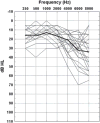Auditory evoked response to gaps in noise: older adults
- PMID: 21385014
- PMCID: PMC4788511
- DOI: 10.3109/14992027.2010.526967
Auditory evoked response to gaps in noise: older adults
Abstract
Objective: The objective of this study was to describe the auditory evoked response to silent gaps for a group of older adults using stimulus conditions identical to those used in psychophysical studies of gap detection.
Design: The P1-N1-P2 response to the onsets of stimuli (markers) defining a silent gap for within-channel (spectrally identical markers) and across-channel (spectrally different markers) conditions was examined using four perceptually-equated gap durations.
Study sample: A group of 24 older adults (mean age = 63 years) with normal hearing or minimal hearing loss participated.
Results: Older adults exhibited neural activation patterns that were qualitatively different and more frontally oriented than those observed in a previous study (Lister et al., 2007) of younger listeners. Older adults showed longer P2 latencies and larger P1 amplitudes than younger adults, suggesting relatively slower neural travel time and altered auditory inhibition/arousal by irrelevant stimuli.
Conclusion: Older adults appeared to recruit later-occurring T-complex-like generators for gap processing, compared to earlier-occurring T-complex-like generators by the younger group. Early and continued processing of channel cues with later processing of gap cues may represent the inefficiency of the aging auditory system and may contribute to poor speech understanding in noisy, real-world listening environments.
Conflict of interest statement
Figures







References
-
- Alain C, Schneider J. Age-related differences in auditory evoked responses during rapid perceptual learning. Clinical Neurophysiology. 2008;119:356–366. - PubMed
-
- Barsz K, Ison J, Snell K, Walton J. Behavioral and neural measures of auditory temporal acuity in aging humans and mice. Neurobiology of Aging. 2002;23:565–578. - PubMed
-
- Ceponiene R, Westerfield M, Torki M, Townsend J. Modality-specificity of sensory aging in vision and audition: Evidence from event-related potentials. Brain Research. 2008;1215:53–68. - PubMed
-
- Cohen M. Coronal topography of the middle latency auditory evoked potentials (MLAEPs) in man. Electroencephalogr Clin Neurophysiol. 1982;53:231–236. - PubMed
-
- Creasey H, Rapoport S. The aging human brain. Annals of Neurology. 1985;17:2–10. - PubMed
Publication types
MeSH terms
Grants and funding
LinkOut - more resources
Full Text Sources
Medical
Miscellaneous
